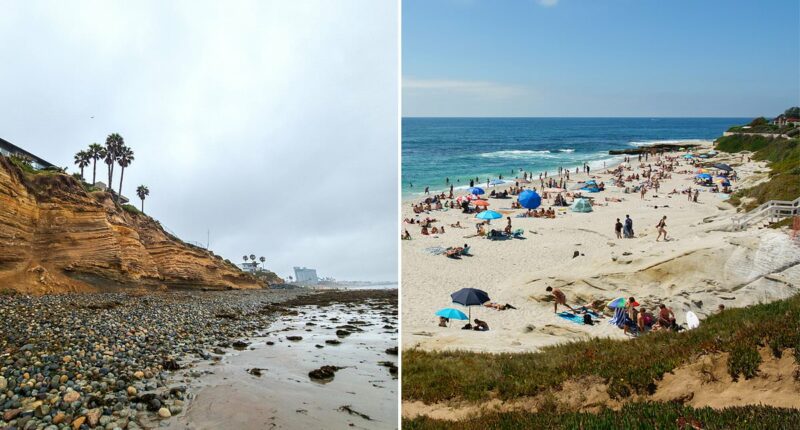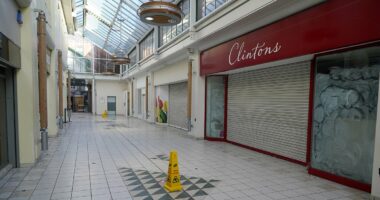Share this @internewscast.com
San Diego’s well-loved beaches are facing significant transformations due to a new city initiative designed to address rising sea levels. This plan, however, has met resistance from locals who believe the changes are too extreme.
The City Council has given unanimous approval to the Coastal Resilience Master Plan, a comprehensive strategy that aims to re-envision key beach areas like Sunset Cliffs, Ocean Beach, Tourmaline Surf Park, Mission Beach, and La Jolla Shores.
The plan replaces traditional seawalls and other hard infrastructure with nature-based solutions like sand dunes, berms, and pedestrian trails.
Officials state the initiative’s purpose is to safeguard public areas, private assets, and infrastructure from escalating issues such as coastal erosion and flooding. However, residents argue that the city is prioritizing climate concerns over practical solutions.
Community organizations are expressing concerns about how proposed changes—such as reducing traffic lanes, modifying beach access, and introducing paid parking—could alter everyday life and the unique vibe of these popular coastal spots.
“This plan doesn’t appear to be well considered,” Scott McCaskill from the Ocean Beach Community Foundation commented during a heated public meeting. “There’s been nearly unanimous opposition to the notion of implementing paid parking at the cliffs or in Ocean Beach.”
‘This is not about protecting the coast – it’s about pushing a political agenda,’ McCaskill said.
One of the more controversial ideas includes reducing Sunset Cliffs Boulevard to a single lane while implementing paid parking—a proposal that surprised many residents and community organizations with its sudden introduction.

San Diego’s most popular beaches are set for major changes under a new city plan aimed at combating sea-level rise – sparking pushback from residents who say the proposals go too far. La Jolla’s Windansea Beach is pictured last month

Tourmaline Surf Park is set to shift from purely hard infrastructure to a greener, softer coastal edge – aiming to fortify against sea-level rise while giving back to the natural environment
The iconic cliffside drive, long considered a sanctuary for surfers, families, and tourists, could be dramatically reshaped with traffic lanes replaced by bike paths and walking trails, and crucial beach access potentially lost.
Others warn that rerouting traffic through residential neighborhoods would create dangerous bottlenecks and erode community safety.
Javier Saunders of the Peninsula Community Planning Board said the plan ignores historical precedent.
‘While nature-based solutions may provide some environmental benefit,’ he said, ‘they are inadequate on their own to protect public infrastructure.
The U.S. Army Corps of Engineers saved Sunset Cliffs in the 1970s using old-school seawalls and engineering – not sand dunes.’
Originally a focal point of the new plan, Mission Beach was abruptly yanked from the city’s list of fast-tracked projects after lifeguards raised alarm about narrowed beach access and blocked rescue routes.
Without being a priority, the project now lacks a guaranteed funding stream – joining a similar delay at La Jolla Shores, where the city proposed a new ‘seatwall’ in the existing parking lot to function as both a seawall and a public bench.
Councilmember Joe LaCava, who represents Pacific Beach and La Jolla, defended the plan saying, ‘What we had yesterday won’t be there tomorrow unless we take action today.’

La Jolla Shores is being considered for coastal enhancements, centered on either reinforcing the shoreline with built features that blend into the landscape or reimagining how the park and parking are arranged entirely

Sunset Cliffs is set to receive nature-focused updates to trails, safety features, and landscape restoration. Traffic patterns will shift to a one-way layout, while new pathways for people walking or biking will improve access
But critics argue that LaCava and his colleagues are gutting traditional coastal protections and prioritizing climate optics over practical solutions.
The Dog Beach area of Ocean Beach is another flashpoint, where the city wants to build elevated sand dunes to prevent flooding while simultaneously creating pedestrian and bike paths along the shoreline.
At Tourmaline Beach the plans include reconfiguring stormwater access and adding vegetated dunes.
To many, it’s a utopian fantasy divorced from the real-world needs of beachgoers.
In an attempt to quell the fury, Councilmember Jennifer Campbell tried to downplay the plan’s scope.
‘These are conceptual ideas,’ she insisted. ‘We are in the trying-to-figure-it-out phase.’
But such reassurance did little to pacify locals, who fear the damage will be irreversible long before any ‘engineering analysis’ is completed.
Kelley Stanco, assistant planning director, admitted the designs are high-level and will require years of study before construction begin – but critics fear it is merely a formality and that the decision has all but been approved.

The plans replace traditional seawalls and other hard infrastructure with nature-based solutions like sand dunes, berms, and pedestrian trails.

According to city projections, sea levels may rise up to 7 feet by 2100, putting an estimated $8 billion in commercial sales and thousands of businesses at risk countywide
Environmental groups have lined up in support.
More than a dozen organizations submitted a joint letter endorsing the plan, arguing it will enhance habitat, improve recreation access, and help meet the city’s obligations under Climate Resilient SD – a broader initiative launched in 2021 targeting climate adaptation for low-income neighborhoods.
According to city projections, sea levels may rise up to 7 feet by 2100, putting an estimated $8 billion in commercial sales and thousands of businesses at risk countywide.
Already, about $150–230 million in city-owned infrastructure could be vulnerable by 2050 if no action is taken.
Councilmember Stephen Whitburn warned the council not to delay.
‘San Diego’s 17 miles of coastline are what make this city special,’ he said. ‘They face real threats from flooding and erosion that are only expected to worsen. This plan sets our coastline up for long-term success.’
But longtime residents aren’t so sure. Many say the real threat isn’t climate but the city’s own bureaucratic overreach, which could forever alter the character of the beaches that define San Diego’s identity.
‘They call it resilience,’ McCaskill said. ‘But we call it destruction.’

















